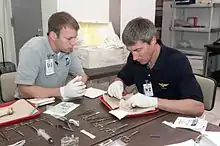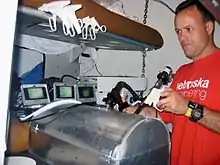Medical treatment during spaceflight
It is inevitable that medical conditions of varying complexity, severity and emergency will occur during spaceflight missions with human participants. Different levels of care are required depending on the problem, available resources and time required to return to Earth.
All medical problems have the potential to affect the mission, but significant illnesses or trauma will result in a high probability of mission failure or loss of crew. As the distance that missions travel from Earth increases, more possible medical conditions and types of trauma need to be evaluated. Return to Earth will be highly unlikely or very difficult depending on the distance traveled. Emergency health care will, and psychological support may, have to be self-administered and could possibly be completely autonomous. The most effective way to provide adequate support is to establish a thorough pre-flight health status assessment and develop a systematic approach to autonomous health care in space.[1]
For NASA, specific provisions and requirements for medical services during space missions are outlined in NPD 8900.5B NASA Health and Medical Policy for Human Space Exploration, NPD 8900.1G Medical Operations Responsibilities in Support of Human Space Flight Programs and NASA-STD-3001 NASA Spaceflight Human Systems Standard - Volume 1, Crew Health.
In flight
| Medical Event or System by ICD9* Category | Number | Percent of Total |
|---|---|---|
| Space adaptation syndrome | 788 | 42.2 |
| Nervous system and sense organs | 318 | 17.0 |
| Digestive system | 163 | 8.7 |
| Skin and subcutaneous tissue | 151 | 8.1 |
| Injuries or trauma | 141 | 7.6 |
| Musculoskeletal system and connective tissue | 132 | 7.1 |
| Respiratory system | 83 | 4.4 |
| Behavioral signs and symptoms | 34 | 1.8 |
| Infectious diseases | 26 | 1.4 |
| Genitourinary system | 23 | 1.2 |
| Circulatory system | 6 | 0.3 |
| Endocrine, nutritional, metabolic, and immunity disorders | 2 | 0.1 |
| *International Classification of Diseases, 9th Ed. |
Non-emergencies
Most medical conditions that occur while in flight do not constitute a medical emergency and can be treated with medication, if available. Some documented non-emergency conditions that have occurred while in space include,[3] Space Adaptation Sickness, motion sickness, headache, sleeplessness, back pain, trauma, burns, dermatological conditions, musculoskeletal conditions, respiratory illness and genitourinary problems.

Emergencies
Potential medical emergencies during space flight[3] arrhythmias, heart attack, stroke, embolism, massive hemorrhage, emergencies related to renal stone formation, infection and thrombotic complications.
To date, arrhythmias, renal colic, venous thrombosis, and infections have been documented during space flights. The documented arrhythmias were mostly mild abnormalities, but potentially serious arrhythmias have been reported.[3][4]

The manifestation of coronary artery disease has not been registered during any human space flight, but considering the risk of coronary events in older people and the increasing age of crew members, the possibility of complications during long-duration missions should not be ignored.[3] Other medical emergencies that have been observed in space include rare but real cases of urological [5][6] and dental emergencies.[7][8]
Additional consideration substantiates the risk of the inability to treat crew members on long-duration missions.[3]
Radiation
Radiation exposure may affect the general health of crew members and cause radiation specific pathological processes. Emergencies due to radiation exposure would most likely be catastrophic and mission ending.[3]
Other risks
Other considerations for designing space medical care systems[3] include exposure to toxic substances, chemical burns, electrical burns and trauma (on board and during EVA's). Exposure to a range of hazards including chemical substances, microbes, radiation and noise can be prevented or controlled by the application of effective astronautical hygiene practice.
A 2006 Space Shuttle experiment found that Salmonella typhimurium, a bacterium that can cause food poisoning, became more virulent when cultivated in space.[9] On April 29, 2013, scientists in Rensselaer Polytechnic Institute, funded by NASA, reported that, during spaceflight on the International Space Station, microbes seem to adapt to the space environment in ways "not observed on Earth" and in ways that "can lead to increases in growth and virulence".[10] More recently, in 2017, bacteria were found to be more resistant to antibiotics and to thrive in the near-weightlessness of space.[11] Microorganisms have been observed to survive the vacuum of outer space.[12][13]
On the ground

Ground-based incidences of illness encountered by individuals exposed to harsh environments (Antarctic expeditions, submarines and undersea habitats) could be considered as analogs of the space environment. These crews living and working in harsh environments have had medical emergencies such as intracerebral hemorrhage, stroke, myocardial infarction (heart attack), appendicitis and bone fractures. Cases of cancer and psychiatric illness were also documented.[14]
Dental problems were the most common emergency during submarine and Antarctic expeditions and were a cause for transfer in the U.S. Polaris submarine program.[14]
Risk estimates made from data provided by analog studies have certain limitations for long duration missions. Unique problems that are inherent to the space environment include the effects of radiation, exposure and physiological adaptation to low gravity. Cardiovascular events are of particular interest for long duration space missions and other harsh environments. To use United States Air Force (USAF) aviators as an example, even though they undergo a very rigorous health screening, the first manifestation of CAD (coronary artery disease) is a cardiac event. Even though the health assessment for an astronaut is more extensive than USAF aviators, data collected from USAF aviators are applicable to the astronaut corps and emphasizes the risk of occurrence of sudden death or heart attack in space despite thorough screening.[14]
Appendicitis is the most common general surgical condition for the submarine program and has been the cause of one death on an Antarctic expedition. Other serious conditions reported in the submarine program and Antarctic expeditions include traumatic amputations, fractures, dislocations, depression and anxiety.[14]
Exploration scenarios
These documented conditions serve as a basis for the Exploration medical list. This list is currently under development and will assist in planning research and development activities. A medical support system is being developed to ensure that adequate medical care can be administered autonomously or with support from ground crews on Earth.
Computer based simulators
The Integrated Medical Model (IMM), a computer based simulator that quantifies the probability and consequences of medical risks, is currently being developed.[15]
See also
- Astronautical hygiene
- Bioastronautics
- Effect of spaceflight on the human body
- Human analog missions
- Illness and injuries during spaceflight
- Space adaptation syndrome
- Space colonization
- Space exposure
- Space medicine § Ultrasound microgravity
- Space survival
References
- Risin, Diana. "Risk of Inability to Adequately Treat an Ill or Injured Crew Member" (PDF). Human Health and Performance Risks of Space Exploration Missions: Evidence reviewed by the NASA Human Research Program. p. 241. Retrieved 23 May 2012.
- Ball, John R.; Evans, Charles H., eds. (2001). Safe Passage : Astronaut Care for Exploration Missions. Washington, D.C.: National Academy Press. ISBN 978-0-309-50009-8.
- Risin, Diana. "Risk of Inability to Adequately Treat an Ill or Injured Crew Member" (PDF). Human Health and Performance Risks of Space Exploration Missions: Evidence reviewed by the NASA Human Research Program. pp. 241–244. Retrieved 23 May 2012.
- Auñón-Chancellor, Serena M.; Pattarini, James M.; Moll, Stephan; Sargsyan, Ashot (2020). "Venous Thrombosis during Spaceflight". New England Journal of Medicine. 382 (1): 89–90. doi:10.1056/NEJMc1905875. PMID 31893522.
- Berry, CA (1974). "Medical legacy of Apollo". Aerosp Med. 45 (9): 1046–1057. PMID 4153403.
- Lebedev, V. (1983). Diary of a cosmonaut. 211 days in space. New York: Bantam Books.
- Newkirk, D. (1990). Almanac of Soviet manned space flight. Houston: Gulf Publishing Company.
- Brown, L.R.; Frome, W.J.; Handler, S.; Wheatcroft, M.G.; Rider, L.J (1977). "Skylab oral health studies". Biomedical Results from Skylab. Washington, D.C.: NASA. Archived from the original on 2012-09-26.
- Caspermeyer, Joe (23 September 2007). "Space flight shown to alter ability of bacteria to cause disease". Arizona State University. Retrieved 14 September 2017.
- Kim W, et al. (April 29, 2013). "Spaceflight Promotes Biofilm Formation by Pseudomonas aeruginosa". PLOS One. 8 (4): e6237. Bibcode:2013PLoSO...862437K. doi:10.1371/journal.pone.0062437. PMC 3639165. PMID 23658630.
- Dvorsky, George (13 September 2017). "Alarming Study Indicates Why Certain Bacteria Are More Resistant to Drugs in Space". Gizmodo. Retrieved 14 September 2017.
- Dose, K.; Bieger-Dose, A.; Dillmann, R.; Gill, M.; Kerz, O.; Klein, A.; Meinert, H.; Nawroth, T.; Risi, S.; Stridde, C. (1995). "ERA-experiment "space biochemistry"". Advances in Space Research. 16 (8): 119–129. Bibcode:1995AdSpR..16..119D. doi:10.1016/0273-1177(95)00280-R. PMID 11542696.
- Horneck G.; Eschweiler, U.; Reitz, G.; Wehner, J.; Willimek, R.; Strauch, K. (1995). "Biological responses to space: results of the experiment "Exobiological Unit" of ERA on EURECA I". Adv. Space Res. 16 (8): 105–18. Bibcode:1995AdSpR..16..105H. doi:10.1016/0273-1177(95)00279-N. PMID 11542695.
- Risin, Diana. "Risk of Inability to Adequately Treat an Ill or Injured Crew Member" (PDF). Human Health and Performance Risks of Space Exploration Missions: Evidence reviewed by the NASA Human Research Program. pp. 244–246. Retrieved 23 May 2012.
- Risin, Diana. "Risk of Inability to Adequately Treat an Ill or Injured Crew Member" (PDF). Human Health and Performance Risks of Space Exploration Missions: Evidence reviewed by the NASA Human Research Program. p. 246. Retrieved 23 May 2012.
External links
- Scott Dulchavsky trains astronauts to diagnosis their injuries in space
- Musculoskeletal injuries and minor trauma in space: incidence and injury mechanisms in U.S. astronauts
- Human Research Facility Ultrasound on the International Space Station (Ultrasound)
- Virtual display could diagnose illness in space
- Prophylactic surgery prior to extended-duration space flight: Is the benefit worth the risk?
![]() This article incorporates public domain material from Human Health and Performance Risks of Space Exploration Missions (PDF). National Aeronautics and Space Administration. (NASA SP-2009-3405).
This article incorporates public domain material from Human Health and Performance Risks of Space Exploration Missions (PDF). National Aeronautics and Space Administration. (NASA SP-2009-3405).